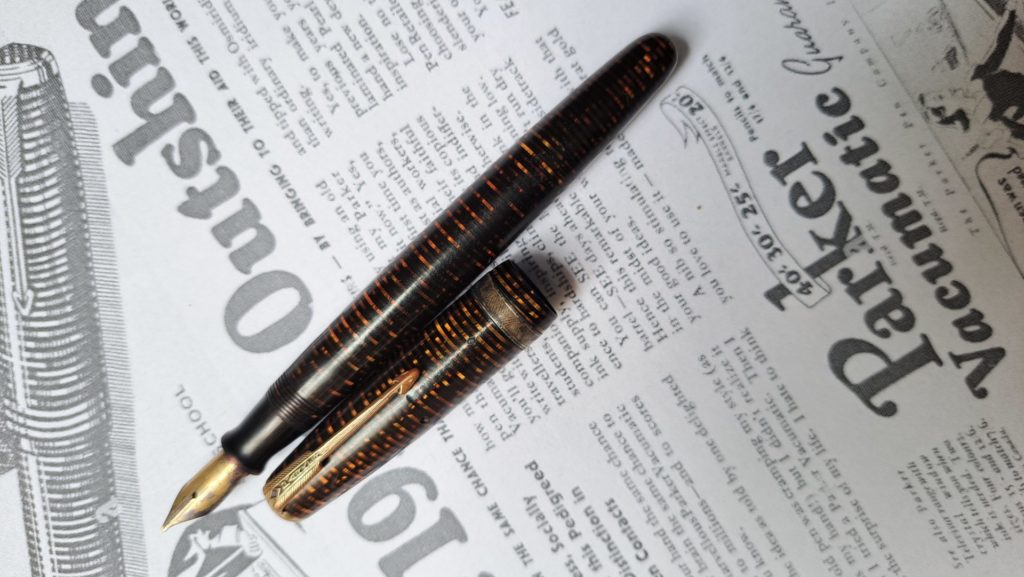The great depression had brought the roaring twenties to a cruel halt in the USA. Fountain pen sales, had plummeted, resulting in a number of pen brands going irretrievably under. The big four – Parker, Sheaffer, Waterman and Eversharp – were battered, with some facing sales losses of upwards of 50 percent, to give an indication of just how terrible the times really were. But the thing that needs to be underscored is that despite the despicable situation, the major fountain pen manufacturers hadn’t really done away with either innovation, or advertising. As a matter of fact, some fountain pen models that still enthrall us today, trace back their origin to this period of darkness. The tough had indeed got going, when the going had got tough. There is a lesson out there for manufacturers today, but that is another story.
Take the case of Parker. Duofold, you will recall, was reigning in its full glory. But, like the foresighted leader that Parker was, it knew that it needed a worthy successor. And like all other major manufacturers, Parker had identified the filling system to focus its attention on as early as the mid-1920’s. The lever filling system was a bit of an eyesore to many, and levers were often manhandled, leading to messy situations, leading to the button enclosed by a blind cap at the bottom of the pen barrel end that activated a pressure bar being the preferred filling mode.
However, just how committed Parker was to innovation, even in those dark days of depression, will be evident if a few facts are shared. A patent was acquired from a certain Prof. Dahlberg of Wisconsin University, which was about a new filling system, which needed a huge amount of input from the engineers at Parker to make it commercially viable by developing on it and making it mechanically perfect. Joseph Platt, a noted New York based designer was engaged to design a pen around it. DuPont was approached to supply the then revolutionary new material – plastic – for the pen, though there appeared to have been a considerable amount of skepticism within the Parker thinktank about the ability of the vendor to supply it with the exact kind of striped pattern celluloid that the design of the pen demanded. That addressed, a design patent was applied for the material and obtained. The uneven coloring, stripes, and the reflectivity of the pearlescent material, were all guaranteed to create a blast and they did. What needs to highlighted, and I do this aware of the fact that I am repeating myself, is that Parker did this at a time which had had no precedence for fountainpen makers – the actual time spent for the development of the pen was five years, and it had sucked in upwards of US$ 125,000 in its development by some conservative estimates! That is the kind of commitments that fountain pen folklores are made of, and what Parker had unveiled was certainly stuff, that legends are made of.
The first pens of the series were test marketed in July 1932 and legend has it that such was the initial response from the Parker sales team and the store owners, that the pen was seen as heralding “the end of the depression”. Yes, we are talking about the Parker Golden Arrow, variably also known as the Vacuum Filler or even the Vacumatic (The Vacumatic christening apparently happened in 1933 as part of a Parker marketing offensive that was by then sure about having a winner in their hands and wanted to milch it to the fullest). The pen was a radical move forward and Parker had pushed it as the first self-filler without a sac, its filling mechanism a definite innovation, which by using a diaphragm instead of a sac could use the whole barrel as a reservoir for ink. As for its looks, what is there to say? In those depression days, it was Katharine Hepburn, Bette Davis and Vivien Leigh rolled into one.
The Parker’s Arrow, one of the most visually well-known trademarks of Parker, was linked to this pen and it had a distinct body imprint: Geo S Parker, Golden Arrow, Made in USA. The Vacumatic had a full range and continues to be a perennial favourite with the collectors, the Golden Arrow imprinted nibbed fountain pens and the Golden Arrow pencils being specially sought after because of their relative rarity.
The Golden Arrow in my collection is a senior citizen in the real sense of the term. He has lived his life to the lees. Has seen the good times with the bad, but does not scoff at anything, choosing to remain in the high alter, looking at, but never down at the fountain pen life forms that have come after him. His nib is slightly damaged, having certainly have had a fall sometime in the past, but I have not got it mended as I like writing with it the way it is, adjusting my writing to fall into his groove, as opposed to getting mechanical / medical procedures conducted to “fix” it. Somehow, it has a weather-beaten face, with scars that give it the character, each mark telling the tale of a time that was years before I was even born that I find fascinating. Why tinker with history to make it palatable and suit my narrative? Me feels that would be sacrilege, don’t you?

